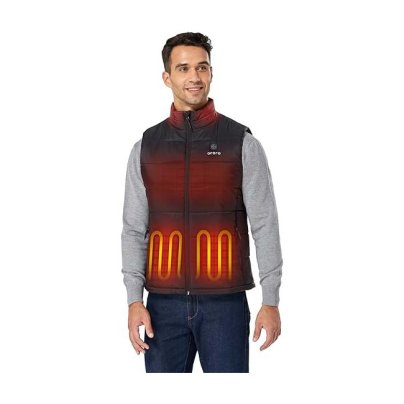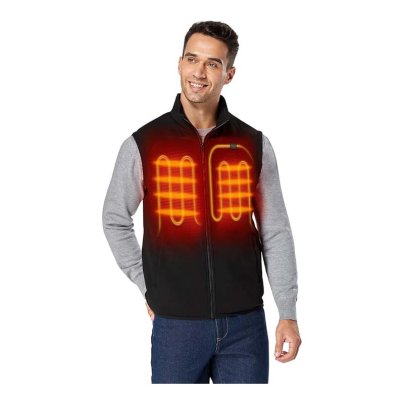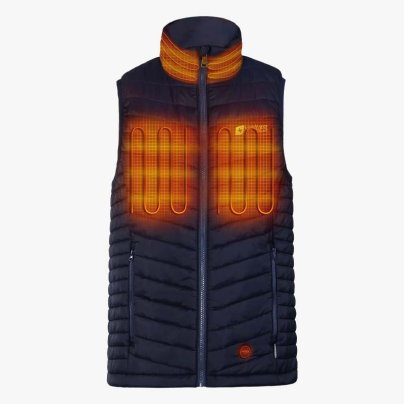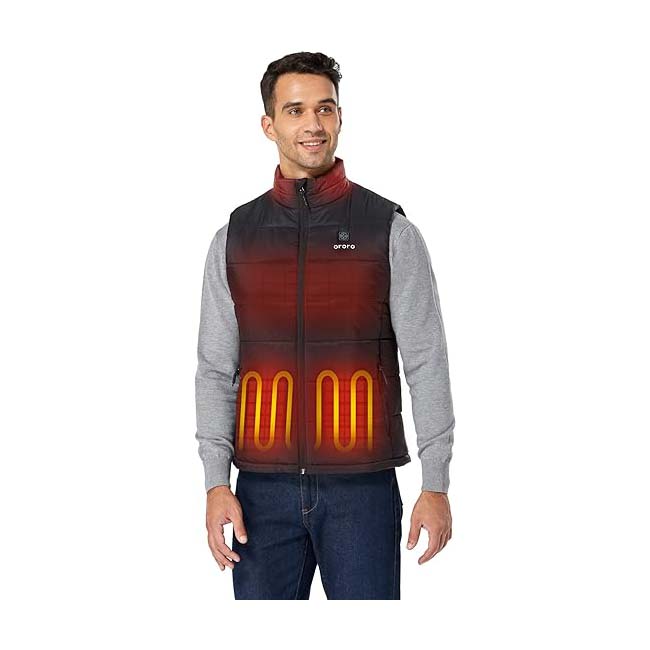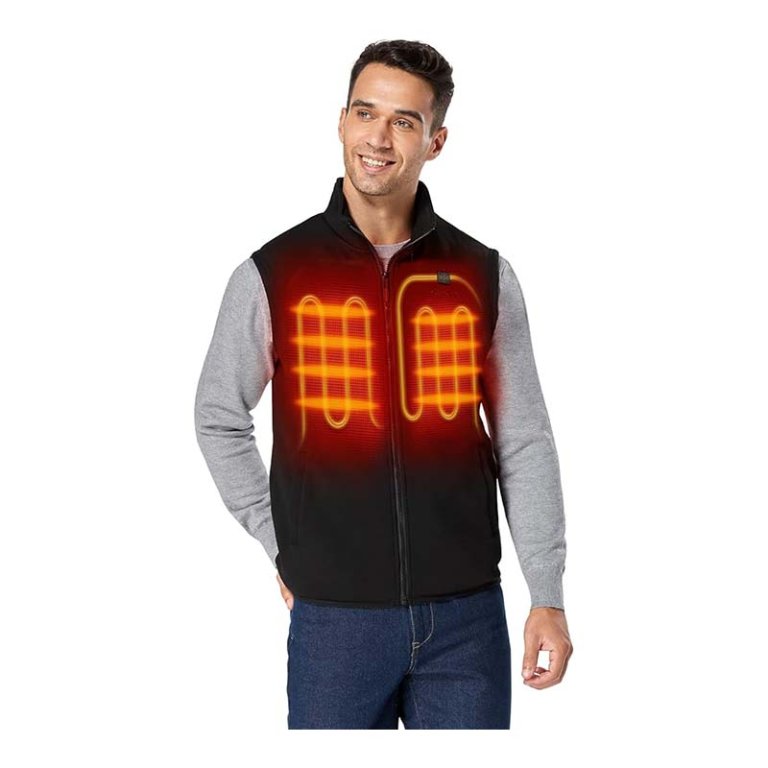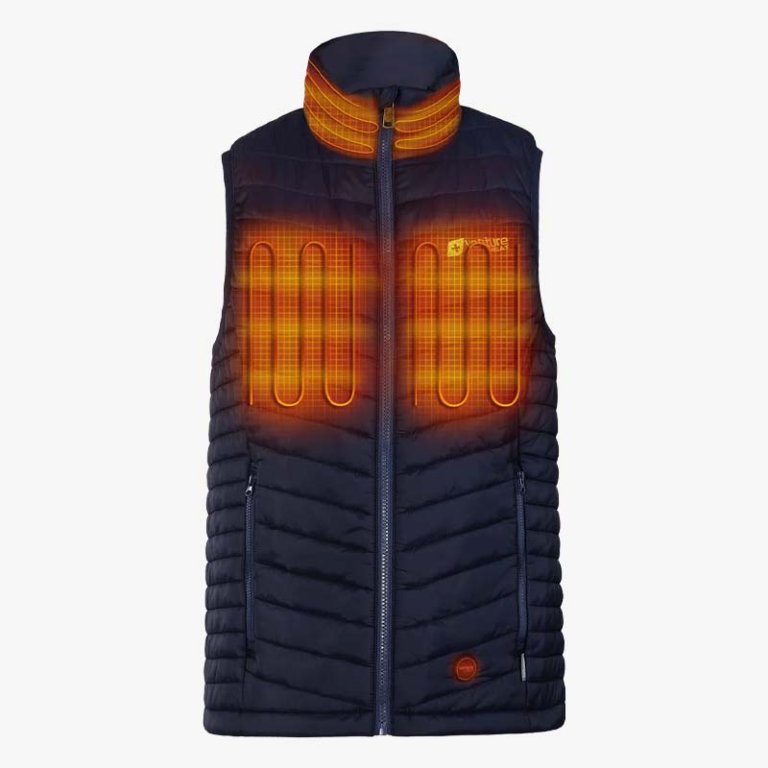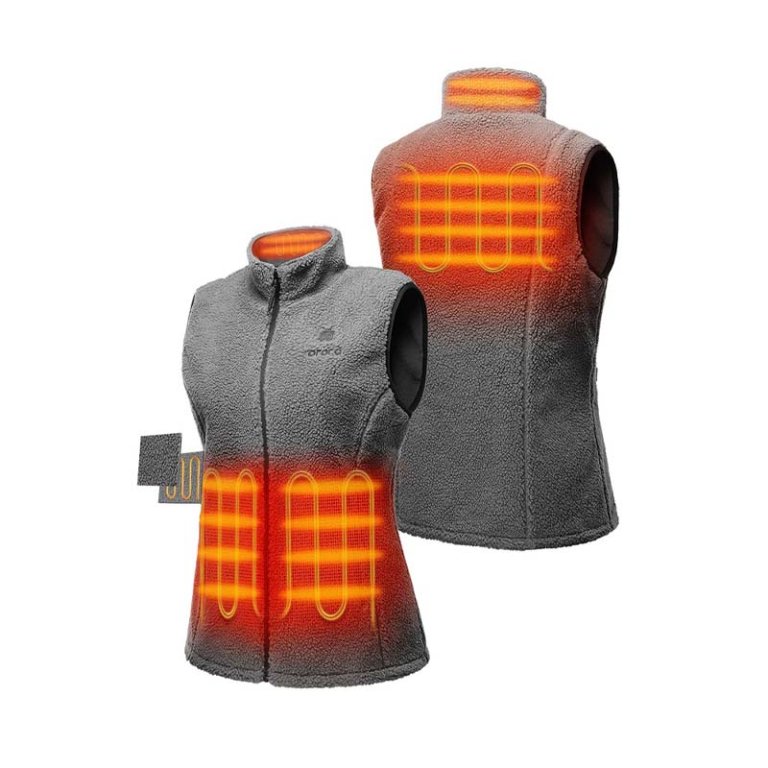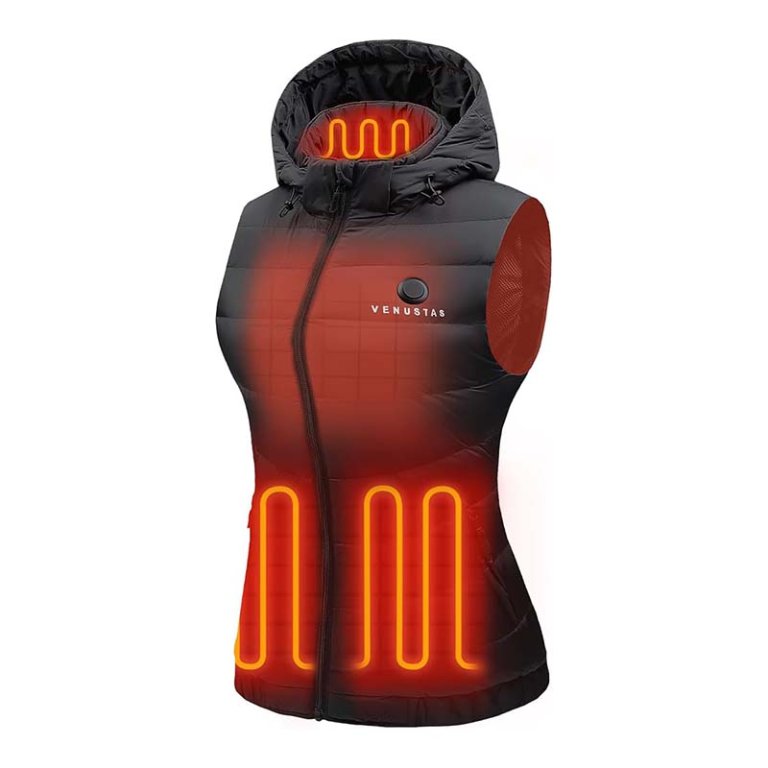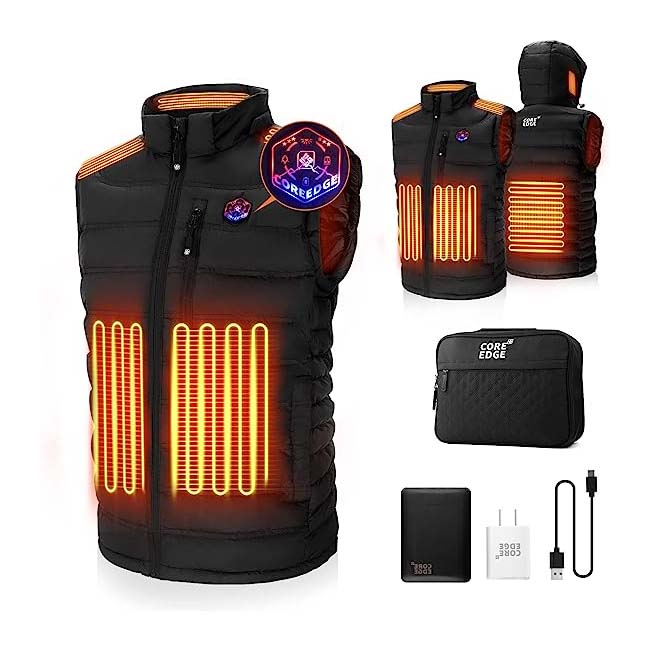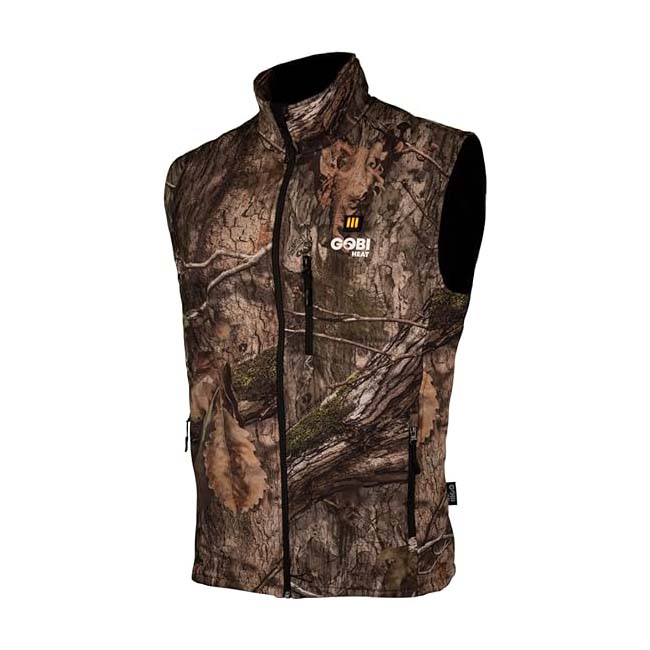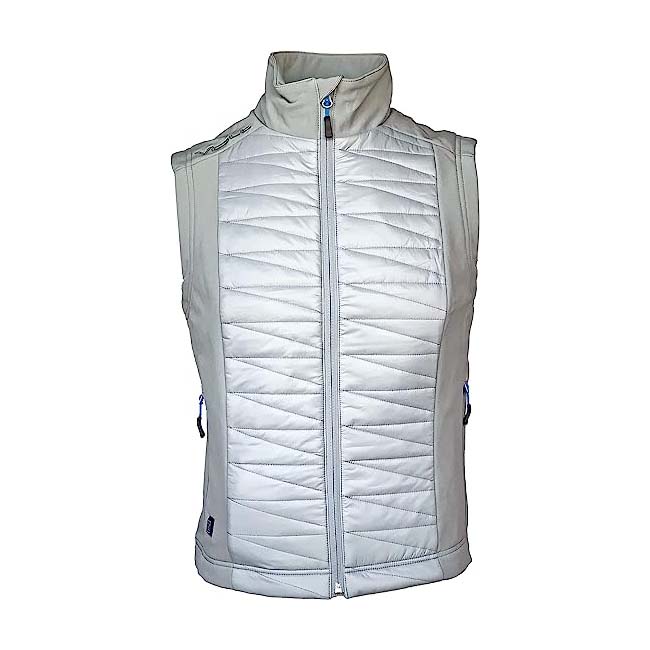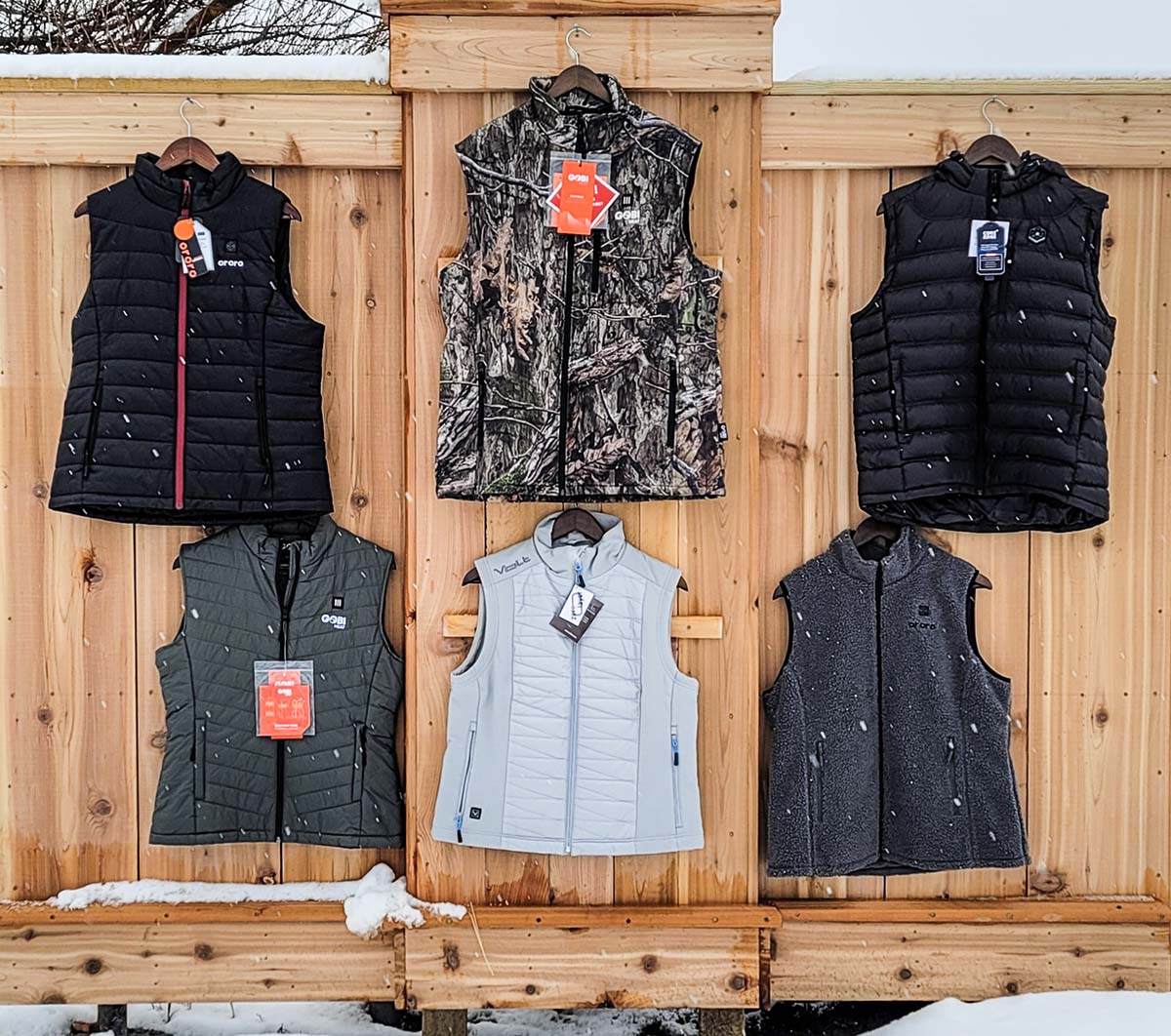
We may earn revenue from the products available on this page and participate in affiliate programs. Learn More ›
When temperatures drop, working outdoors can become downright uncomfortable if you don’t have a way to stay warm. Moving freely is essential in many outdoor occupations, including construction, surveying, and landscaping, so piling on constricting clothing layers isn’t usually an option. That’s where heated vests come in: These typically lightweight garments, which fit easily over a shirt or under a jacket, feature battery-heated panels that help keep your core warm so you can continue to work. Our favorite, Ororo Men’s Light Weight Heated Vest, is flexible enough despite its wiring and warms in three places: the collar, the mid-back, and the lower front of the vest.
The best heated vest for you depends on the outdoor temperature and how much additional heat you need to keep warm and comfortable. Ahead, learn what to look for in a heated vest, and find out how the following models fared in our extensive hands-on testing.
- BEST OVERALL: Ororo Men’s Light Weight Heated Vest
- BEST BANG FOR THE BUCK: Ororo Men’s Heated Fleece Vest
- BEST FOR WOMEN: Venture Heat Women’s Heated Puffer Vest With HeatSync
- BEST RECYCLED FABRIC: Ororo Women’s Heated Recycled Fleece Vest
- BEST WITH HOOD: Venustas Women’s Detachable Hood Heated Down Vest
- BEST HEATED HOOD: CoreEdge Heated Vest With Detachable Heated Hood
- BEST FOR SPORTSMEN: Gobi Heat Colorado Men’s Heated Hunting Vest
- BEST BLUETOOTH: Volt Women’s Heated Vest With Bluetooth
- MOST VERSATILE: Ororo Women’s Classic Heated Vest
- BEST LOW-PROFILE: ActionHeat Adult 5V Heated Vest Liner
Our Top Picks
When we tested the following heated vests, the outdoor temperature was between 25 and 50 degrees Fahrenheit during the day, dipping into single digits overnight. With the addition of high winds on some days, the wind chill hovered around 0 degrees Fahrenheit, so we had plenty of opportunities to enjoy the warmth generated by the vests.
The following heated vests feature varying levels of heat distribution, ease of use, functionality, and comfort. The best heated vest to keep you warm often depends on how low the temperatures dip in the region, how long you will be out in the cold, and how much supplemental heat you need to feel comfortable. Battery runtime was tested at the highest temperature—you can reasonably expect two to three times longer heating on lower settings.
Best Overall
Ororo Men’s Light Weight Heated Vest
Pros
- Vest features a high-quality nylon shell that helped block icy winds
- Addition of a heated neck panel is a welcome touch in cold weather
- Heat panels in the lower front keep both body and hands warm
Cons
- Battery pocket location makes the battery slightly uncomfortable against the hip
Product Specs
- Number of heating panels: 4; 1 on each lower front side, 1 mid-back, 1 in the collar
- Battery included? Yes
- Runtime: Up to 10 hours on Low
The Ororo men’s lightweight heated vest aims to stay warm in all the right places, thanks to three carbon-fiber heating zones located along the back of the collar, in the mid-back, and on the lower front of the vest. This vest features three temperature settings, so users can choose which one best suits the desired warmth needs and outdoor environment. Its heating zones are powered by a rechargeable 7.4-volt battery (included). The manufacturer claims the battery generates heat for only 3 hours on the highest setting, but we put it to the test and got 6 hours of heat generation.
When we tried on the Ororo vest, the first thing that struck us was how supple and comfortable it was. We’d expected it to be slightly stiff or scratchy—with unbending internal wires—but that wasn’t the case at all. While the manufacturer claims the vest is water-resistant, the operating guide that comes with the vest warns against wearing it in wet conditions when the vest is heating.
This vest contains quality materials and is well made—no snags, the seams are well sewn, and the material seems very durable. Our favorite feature was the heating panel in the back of the collar. This heating panel, along with long winter scarves, kept us toasty warm. The soft nylon outer shell blocked most of the cutting wind. All in all, this is a high-quality heated vest that should last for years.
Get the Ororo lightweight heated vest at Amazon, The Home Depot, or Ororo.
Best Bang for the Buck
Ororo Men’s Heated Fleece Vest
Pros
- Cheaper than comparable heated vests in different fabrics
- Fleece-lined pockets keep hands warm and dry during use
- The high-zip neck helps block cold air from entering at the neckline
Cons
- The soft fabric is comfortable, but it isn’t windproof
- Position of the battery causes it to rub on the user’s side
Product Specs
- Number of heating panels: 3; right chest, left chest, 1 mid-back
- Battery included? Yes
- Runtime: Up to 10 hours on Low
Get the warming comfort of a heated vest at a great price point. When the Ororo fleece heated vest arrived, we expected the fleece to be similar to a fluffy bathrobe. That’s not the case at all. The fleece part is the lining—the inside of the vest—but the outer shell is made from a cotton/polyester blend that’s thicker and more durable but still breathable. This vest is designed for comfort—it’s soft and supple, and the inside of the pockets have the same fleece lining.
The significant upside to the Ororo fleece vest is how well it breathes; there’s no problem with sweat building up. The wind did blow through the fabric a bit—more than it did with the vests that come with nylon shells—but not enough to send us back indoors. The vest is also designed with a high zip-up neck to help keep cold air out. A slight downside: The battery compartment is located inside the vest (a bit to the side), which is not the most comfortable spot for the battery.
The vest features three heat zones, including two on the chest and one along the upper back. It allows the wearer to choose from three adjustable temperature settings to cater to individual comfort and the outdoor environment. After fully charging the battery overnight, the vest generated heat for almost 5½ hours on High. We would wear this vest on moderately cool days but hesitate to wear it—without an overcoat—on truly frigid days. Best of all, it comes at a good price for a heated vest that breathes and won’t trap sweat.
Get the Ororo fleece heated vest at Amazon, Walmart, or Ororo.
Best for Women
Venture Heat Women’s Heated Puffer Vest With HeatSync
Pros
- Very soft, comfortable fabric with a wind-resistant exterior
- Heated collar for added warmth and protection against cold winds
- Roomy front pockets zip for securely holding keys and small items
Cons
- Pockets feature nylon lining and do not have heating elements
Product Specs
- Number of heating panels: 4; right chest, left chest, mid-back, collar
- Battery included? Yes
- Runtime: Up to 10 hours on Low
The tapered waist and wind-cutting high neck of the Venture Heat women’s heated vest give it a stylish look while retaining warmth. It features three large heat zones: one on each side in the chest area and another from shoulder to shoulder along the upper-mid-back region. Plus, there’s one small heat zone in the back of the collar.
We liked that the front heating elements were located in the chest area instead of in the lower abdominal area, as is typical with many heated vests. The downside to this configuration is that the pockets aren’t heated, but we felt warmer overall.
We were able to choose from three different heat settings, and the battery is accessible in a separate compartment inside the vest, which we appreciated. This versatile vest can be worn under a roomy jacket for maximum warmth or over a heavy shirt or sweater.
The 7.4-volt rechargeable battery is included, and after a full initial charge, it kept the vest warm for just under 5 hours on the highest setting. Best of all—from our perspective—is the heating panel in the collar that makes the vest feel so cozy and warm.
Get the Venture Heat heated vest at Venture Heat.
Best Recycled Fabric
Ororo Women’s Heated Recycled Fleece Vest
Pros
- Shearling fleece is made from recycled plastic bottles, making this an eco-friendly vest
- Vest features a tapered waist and roomy hip for a stylish, comfortable fit
- Heating element in the collar helps reduce the effect of cold winds on the neck
Cons
- Vest does not have heating panels in the upper front chest area
Product Specs
- Number of heating panels: 4; right abdomen, left abdomen, mid-back, collar
- Battery included? Yes
- Runtime: Up to 10 hours on Low
The super-soft fleece of the Ororo heated recycled vest for women kept us warm without trapping sweat. Best of all, the yarn used in the fleece shell of the vest is 100 percent recycled plastic bottles, so it’s as eco-friendly as it is comfortable.
The vest comes with a 7.4-volt battery that produced toasty warmth for nearly 4 hours when we ran it on High. It also offers Medium and Low heat settings. It comes with four heat panels: two on either side of the lower front, one on the middle of the upper back, and another one on the back of the neck.
Although the fleece outer shell is made from recycled plastic bottles, it’s not windproof. Called “shearling fleece,” the fabric is designed to breathe, which makes this vest suitable for use under a jacket or coat. Ororo didn’t skimp on style, either. This woman’s vest is tapered in the midsection and slightly flared at the hip for a flattering yet comfortable fit.
We especially enjoyed the neck-heating element. The only thing we would have added was heating panels in the upper front chest area for added warmth.
Get the Ororo recycled fleece heated vest at Ororo.
Best with Hood
Venustas Women’s Detachable Hood Heated Down Vest
Pros
- Down-filled vest is comfy and warm even without activating the heating element
- Detachable hood cinches tight for snug fit to stay in place without blocking line of sight
- Water-resistant fabric helps you stay dry in light rain or snow
- Upper back panel hits back of neck, which is a nice element for a stiff or sore neck
Cons
- Battery pack overheated when charging with the wall outlet adapter
- Slightly bulkier than similar vests
- Heated pockets can get too warm for a phone
Product Specs
- Number of heating panels: 4
- Battery included?: Yes
- Runtime: Up to 10 hours on Low
The Venustas heated vest gets high marks for being warm without even activating the heating element. Filled with 90 percent premium white duck down and lined with a reflective lining, it features four heat zones: right and left pocket; waist (lower back), and upper back. The upper-back zone extends close to the neckline so although the hood and neck are not technically heated, the back of the neck does get warm. The hood is fully lined and detachable by a zipper. When activated via the touch button, the entire vest is warm in less than 10 seconds. The settings are High, Medium, and Low and are generated by a 7.4-volt battery pack with a slightly slimmer footprint than some of the other battery packs we’ve tried.
When charging for the first time, one immediate issue was the battery pack overheating when using the wall outlet adapter. We switched to charging via the USB outlet and did not have this issue again. The battery is easy to install into a small pocket on the inside left of the vest, but be advised the Velcro holding the pocket closed is very strong, so you may have to pull a little harder than you’d expect.
We wore the vest outside multiple times with temperatures fluctuating in the high 20s and low 30s Fahrenheit while walking the dog, doing yard work, etc. When active, we had it on Low or even Off without an additional coat or hat. When stationary, we kept it on Low to Medium. The big test for us was to see how it stood up to the cold of a hockey rink. We wore the vest to a hockey game, where the arena temperature was 39 degrees Fahrenheit. We made a point of standing close to the boards, which is typically the coldest spot in the rink. We wore a thin long-sleeved tee shirt, regular jeans, socks, and boots, but chose not to wear a coat, hat, gloves, or any other layers because we wanted to see how effective this vest could be. The great news is we wore it for 90 minutes in the arena and it kept us plenty warm. We used it on the High setting for the first 30 minutes, turned it down to Medium for the next 30 minutes, and then cranked it up to High again for the last 30 minutes. We also put the hood on at about the 45-minute mark. The heated pockets were a great addition because we had no gloves. While we don’t suggest you go this minimalist in the winter, the vest passed the hockey mom test.
The fit is true to size; however, it is more fitted and less boxy than some of the other vests we tested. It is also significantly bulkier, which means you may want a more oversize coat if you plan to zip up both layers.
Get the Venustas heated vest at Amazon or Venustas.
Best Heated Hood
CoreEdge Heated Vest With Detachable Heated Hood
Pros
- Heated hood offers warmth over the ears for use in the coldest weather
- The CoreEdge heated vest comes with a total of 8 different heating panels
- Hood is detachable; vest can be worn under a roomy jacket if desired
Cons
- May take a while to learn how to toggle through all the various heat-panel combinations
Product Specs
- Number of heating panels: 8; left abdomen, right abdomen, 1 back, 2 shoulders, 1 collar, 2 hood
- Battery included? Yes
- Runtime: Up to 10 hours on Low
The CoreEdge heated vest wasn’t the only one we tested that came with a hood, but it was the only one that featured heated panels in the hood, making it a souped-up pick for the coldest winter days. The vest comes with eight heat panels: two on the front, one on the back, two on the shoulders, one on the collar, and two in the hood.
The hood is detachable—it zips on and off—and all we had to do was connect the front hood flaps, via snaps, for the heating elements in the hood to work. The heating panels in the hood are located over the ears, which we found optimal for keeping not just the ears but the whole head warm, especially when we tightened the hood strings for a snug fit. The hood quickly got too warm, but that’s not a problem—by unsnapping the flaps, we could disconnect the heat from the hood while the rest of the heating panels still worked. We didn’t have to remove the hood to stop the heating.
The CoreEdge heated all panels for almost 5 hours on High, but users have a choice of which panels they want to run. By toggling through the buttons on the control switch button, we could power on the hood, collar, and shoulder panels as a single unit, the front abdomen panels by themselves, or the back panel by itself. We could also turn all of the panels on at once. This offers a lot of heating versatility but also comes with a slight learning curve figuring out which buttons to push to turn on the panels we wanted to heat. By the time we were done testing, we’d mastered the switch.
The vest is lightweight and soft and can be worn over a heavy sweater or under a roomy coat or jacket for added heat retention. Its nylon shell is wind- and water-resistant.
Get the CoreEdge heated vest at Amazon.
Best for Sportsmen
Gobi Heat Colorado Men’s Heated Hunting Vest
Pros
- The outer fabric on this heated vest resists punctures, tears, and water
- Slightly roomy and comes with a longer length than competitors
- Camo fabric is designed to blend in with outdoor wooded settings
Cons
- Only 3 heated panels and no hood
Product Specs
- Number of heating panels: 3; right chest, left chest, 1 back
- Battery included? Yes
- Runtime: Up to 10 hours on Low
All the heated vests in this lineup do a good job at warming their wearer in cold temperatures, but Gobi Heat’s Colorado heated vest comes with an abrasion-resistant exterior that withstands the pokes and snags that can come from walking through underbrush. Plus, it comes in a forest camouflage design that helps users blend in against a backdrop of trees.
Our first impression was that the Colorado heated vest was slightly large for its size. However, we felt this was a plus since outdoor enthusiasts may want to layer more than one shirt beneath it. It’s also thin enough to wear under a roomy jacket or coat for added heat.
While there are only three heated panels on the Colorado vest—two in the chest area and one on the back—they produce plenty of heat. In our tests, the vest continued heating on High for just over 4 hours, but users can extend the heating time up to 10 hours by using Low heat. This basic, no-frills heated vest does what it says—it keeps the wearer warm while providing a tough exterior that blends into the great outdoors.
Get the Gobi Heat heated vest at Amazon, Tractor Supply Co. (women’s), or Gobi Heat.
Best Bluetooth
Volt Women’s Heated Vest With Bluetooth
Pros
- Bluetooth allows users to turn the vest on and control heat settings through the Volt app
- Stylish design with tapered waist and stretchy side panels for looks and comfort
- 2 heat panels in the back keep the entire back toasty warm
Cons
- The inner pocket lining is relatively thin and doesn’t help keep hands warm
Product Specs
- Number of heating panels: 4; 2 chest panels, 2 back panels
- Battery included? Yes
- Runtime: Up to 10 hours on Low
The Volt heated vest for women was the only one we tested with Bluetooth capability. At first, we were ambivalent about whether we would actually use the feature in a real outdoor situation. Still, we changed our minds after finding out how easy it was to control the heat level when wearing a coat over the vest.
We tried out this vest on the coldest testing day. It was just 28 degrees Fahrenheit when we went out, so extra coats were necessary. The Volt vest tapers through the waist and didn’t bind or restrict movement beneath the larger coats. However, once the outer coat, gloves, and hat were all on, we would have had to remove the gloves and unbutton the larger coat to toggle through the vest’s heat settings. Thanks to Bluetooth, we could change the heat setting from our smartphones.
Before we went out, we downloaded the Volt Heated Clothing app to our phone, and it quickly walked us through the setup without any glitches. Changing the heat settings or turning the heat on or off was simple from the app. This vest features four heated panels: two on the chest and two on the back. We really liked the additional back panel since it offered heat at both the upper and the mid-back. The only thing we didn’t like so much was the thin inner pocket lining. We would have liked thicker fabric in that spot for keeping hands warm.
Get the Volt heated vest at Amazon, Volt, or The Warming Store.
Most Versatile
Ororo Women’s Classic Heated Vest
Pros
- Lightweight and packs down small for travel; doesn’t feel bulky while wearing
- Roomy enough fit to layer a thick sweater underneath but thin enough to wear under a coat
- High neck cuts out the wind and neck heating element helps keep overall body temperature warmer
- Colorful zipper gives vest some personality
Cons
- Heated pockets might be too warm to store phone in
Product Specs
- Number of heating panels: 4
- Battery included? Yes
- Runtime: Up to 10 hours on low
The Ororo women’s classic heated vest has a simple, stylish design with four effective heat zones: left and right pockets, upper back, and collar. Activated with a touch button on the chest, the heating zones heat up in less than 10 seconds and are easy to toggle through. The battery is simple to install, fitting in through a small pocket on the inside of the vest. Ideal for layering, the vest is a little on the loose and boxy side. Insulated with a thin polyester fill called Fellex, the Ororo women’s classic is made from an eco-friendly sustainable material. Although it is lined, this vest is not bulky and is easy to layer underneath an additional coat.
We wore the vest outside when temperatures were fluctuating between the low to mid-30s in degrees Fahrenheit. When we were moving, such as walking the dog or raking leaves, the vest kept us warm enough on Low or Medium without any additional layers such as a hat, coat, or even gloves.
We also donned this vest for a hockey game in a cold indoor arena (around 39 degrees Fahrenheit) to give it the ultimate test against the cold. We opted to layer just a long-sleeve tee shirt and wore regular noninsulated boots and jeans. We brought a hat since this vest doesn’t have a hood, but we ended up not needing it. We stood as close as possible to the boards, which is usually the coldest part of the rink. We loved the heated collar, which instantly warmed the back of the neck and relaxed the neck muscles. We kept the vest on High for about 15 minutes, then ended up dropping it to Medium for the next 45 minutes. We started feeling the chill at this point, so we cranked it back up to High for the last 30 minutes of being at the rink. Overall, it kept us warm and toasty, and we felt like it had a little more style than some of the other women’s heated vests we’ve seen thanks to the colorful zipper.
Get the Ororo women’s classic heated vest at Amazon, Walmart, or Ororo.
Best Low-Profile
ActionHeat Adult 5V Heated Vest Liner
Pros
- Minimalist style is ideal for someone who wants a simple layer and no bulk
- Heats up fast and distributes heat effectively
- Lightweight and packs down small enough to be useful for travel
- Allows for freedom of movement; ideal for working in cold weather
Cons
- No pockets other than 1 front external pocket for the battery
- Lacks insulation, so additional layers are a requirement
- Battery runtime is significantly shorter than other heated vests
- Sizing runs small, so be sure to double-check the size chart before ordering
Product Specs
- Number of heating panels: 3
- Battery included? Yes
- Runtime: Up to 4.5 hours on Low
While the other vests on this list can be worn as a stand-alone, the ActionHeat heated vest liner is specifically designed to be worn as a layer. A no-frills style, it lacks any insulation. However, this can be ideal for not restricting movement or adding bulk under a jacket. It is powered by a slim 5-volt battery, which provides warmth in three panels: upper chest left and right as well as upper back. There is only one pocket, which is where the battery pack goes. It’s on the front outside of the vest, making swapping the battery easy. The sizing runs small: the XL fits much more like a men’s medium or large, so be sure to double-check the sizing guidelines before ordering.
We found it easy to use; just hit the touch button for 3 seconds and the vest powers up, with heat distribution in less than 10 seconds. We wore this one outside during temperatures that fluctuated in the low 30s in degrees Fahrenheit and found it a nice addition during active outdoor work or dog walking. Because it’s so low profile, it doesn’t require you to switch up your usual clothing routine, and it kept us warm when used at the Low or Medium settings with the addition of a thick flannel, fleece, or sweatshirt. When more sedentary, such as at the hockey rink watching a game, it felt necessary to keep it on Medium or High, but this is subjective based on personal preferences. Overall, it will keep your core warm, and that will in turn keep you warmer than without a heated vest. The downside is that the slim battery only lasts a couple of hours at High, and once off, it doesn’t provide much residual heat.
The biggest perk of this vest is the freedom of movement it provides, especially while doing outside projects. We’ve been replacing our outdoor pergola before the snow falls, but the temperatures have dipped down into the teens, so having a heated vest to wear under regular clothing has been ideal. This could also work for hunting or other outdoor sports during the winter, but keep in mind the maximum time the battery works.
Get the ActionHeat heated vest at Amazon, Dick’s Sporting Goods, or ActionHeat.
Jump to Our Top Picks
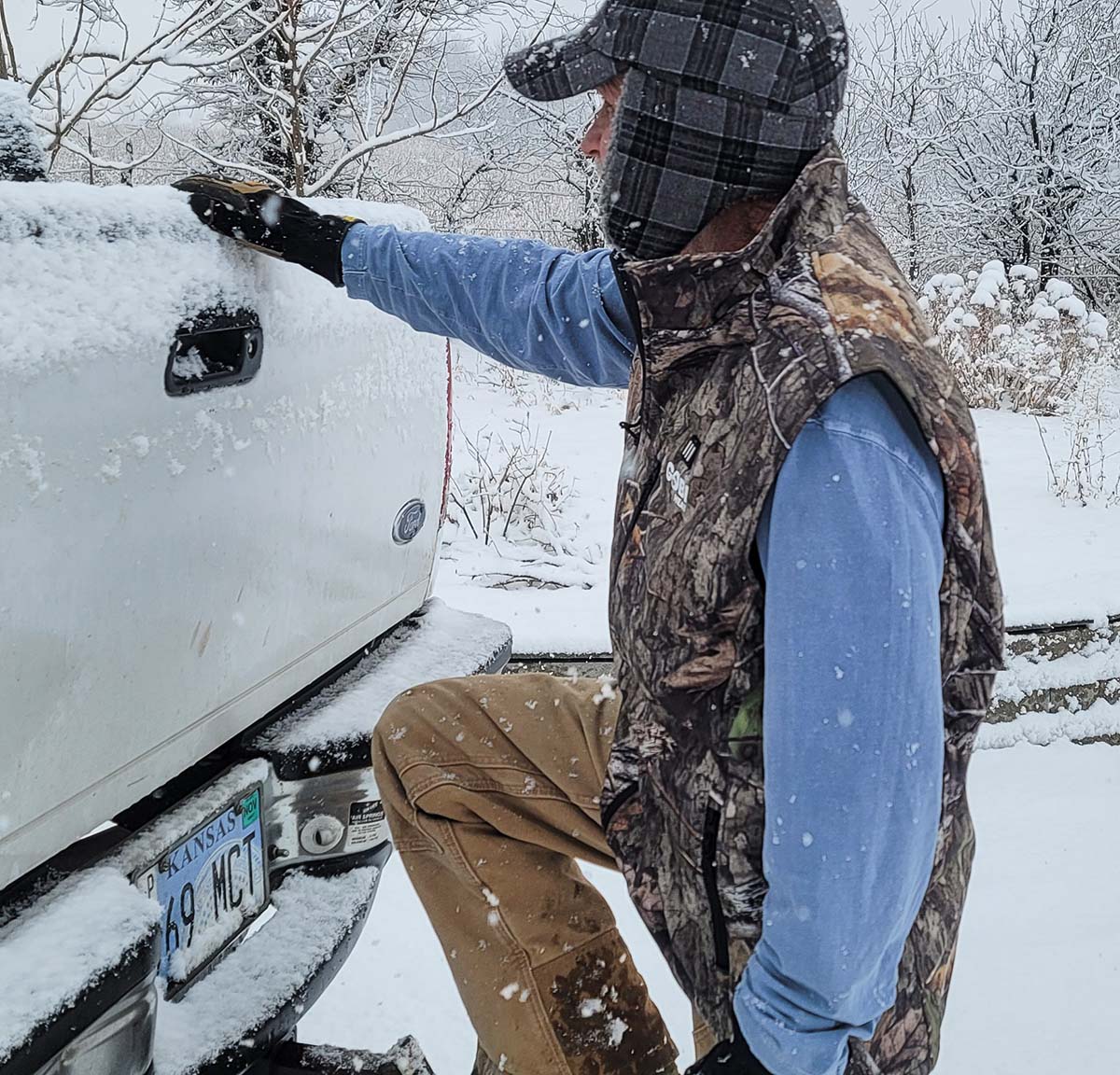
How We Tested the Best Heated Vests
We’d heard a lot about heated vests in the past few years, but we wanted to know if they lived up to the hype, so we tested top sellers with the following questions in mind: Are they cumbersome? Do they really keep your core warm enough to stave off a bitter chill? Will they survive snow, rain, or sleet? We put these vests through their paces, tested all of their functions, and noted how long they stayed warm on a single battery charge.
The two most essential factors in a heated vest are how well it fits and how well it keeps the wearer warm. The first step in the testing process was to fully charge the batteries (of those that came with batteries), so we charged each one overnight to ensure it had a full charge.
We connected the batteries (be aware that some battery connections take a while to find) and cycled the vests through their heat levels. We then turned the vests to the High setting and noted how long the battery produced heat. We wore each vest outdoors and made a note of how comfortable it was when reaching, bending, and twisting, and we also observed how well it blocked the cold wind.
After wearing each vest outdoors for about an hour, we removed it but left the heat zones turned to High. We then checked every 30 minutes to see if the vest was still producing heat and made a note of the time when it stopped heating.
We also examined the quality of the vest’s materials and how well the seams were sewn. We scored each vest using a rubric and then tallied up the final scores to choose the best ones for this lineup.
What to Consider When Choosing a Heated Vest
Heated vests will help raise the body temperature when it’s chilly outdoors, but because they don’t have sleeves, they’re not a substitute for a full coat if the temperatures are bitterly cold. Wear a heated vest over a flannel shirt or sweater when just a bit of warmth is needed or under a heavier coat to provide a temperature boost. Heated jackets are often better for severe cold or long exposure, which we feature in an article here, and are worth considering if shoppers often need to be outside during frigid weather.
Material
When the vests started arriving, we noticed that virtually all of them were either black or dark gray. Fashion is not at the top of the list when it comes to heated vests; function takes precedence in the color as well as the material.
The outer shell of a heated vest can be made of several materials, including fleece or a moisture-resistant polyester blend. Inside there is usually a fleece lining for softness and comfort. Some heated vests feature an outer shell that is moisture-resistant but not completely waterproof, which then traps sweat against the body and can create a clammy feeling. The most comfortable heated vests are often made with fabric that breathes and wicks sweat away from the body.
Many of the heated vests we tested feature an outer nylon shell, which is a good option for moisture resistance when wearing the vest as an outer layer. Others were thinner and less water-resistant but designed to be paired with an overcoat, so they would be protected from getting wet.
Heating Elements
The heating elements in a heated vest include a series of panels with wires that warm different sections of the body. These strategic panels are most commonly placed along the upper back and the chest area of the vest.
Some heated vests offer even more panels, often located in the lower front, lower back, and sometimes along the back of the neck if the vest has a high collar. Depending on the outdoor temperature and the degree of added warmth needed, some people may be happy with just a few panels or want as many as possible.
Temperature Settings
Two or three temperature settings are the norm, allowing users to select just the right temperature for the environment, though some heated vests have one temperature setting: just on and off. The temperature-selection button is commonly found on the vest’s front, either above a chest pocket or on a lower front pocket for convenience.
Some temperature-control buttons feature different-colored lights that make it easy to identify which heating mode is currently in use, such as a red light for the highest temperature, a yellow light for a medium temperature, and a green light for the lowest temperature. By simply pushing the temperature button, wearers can change the warmth level to the most comfortable heat setting.
Voltage, Battery Life, and Runtime
Heated vests require rechargeable batteries or a chargeable power bank. The low-voltage lithium-ion batteries (5 volts and 7.4 volts) used in heated vests will usually hold a charge for 4 to 10 hours, depending on the heat level. The battery will drain more quickly at a higher temperature than it will at a Medium or Low setting.
Most rechargeable batteries have a similar battery life, but typically after 3 to 5 years, a lithium-ion battery loses some of its strength and won’t hold a charge as long as it once did. Extreme cold will also shorten battery life. If the vest doesn’t stay warm as long as it did when it was first purchased, replacing the battery might be all that’s needed to get it back into top working order.
Safety
Although heated vests run on electricity, the voltage is so low that there is no risk of being electrocuted. Many heated vests are even safe in the washing machine—once the battery has been removed, of course.
The rechargeable lithium-ion battery contains ingredients that can irritate skin, eyes, and mucus membranes causing itching, burning, and redness. If a lithium-ion battery becomes damaged and its contents leak, discard the battery and replace it with a new one.
Moisture Resistance
Many of the vests we tested were advertised as being “moisture-resistant” or “water-resistant,” but the owner’s manual that comes with each vest warns the user not to wear the vest if the interior lining is wet, due to a risk of shock.
Any water-resistant properties relate solely to the outer shell of the vests, which is usually made from nylon to block both wind and light rain or snow. The vests are typically washable on the delicate cycle (with the batteries removed) and then hung up to dry.
Additional Features
Many heated vests feature two front pockets at the waist that can come in handy for storing items like a wallet or keys. Some vests offer additional chest pockets and provide a special zippered pocket to keep a mobile phone safe.
While most vests have a zipper front, several button-front models are available as well as hooded models to keep wearers’ heads warm and dry in cold or inclement weather. Some heated vests feature a built-in timer that will automatically turn off the heat after a few hours; if more heat is desired, just turn the vest back on.
FAQs
Wearing a heated vest during outdoor activities can make the difference between feeling cold and miserable or being warm and comfortable. If this is your first time shopping for a heated vest, you likely have some questions. Below are answers to some popular queries about heated vests.
Yes, the lithium-ion batteries used to generate heat are low voltage and will not result in an electrical shock. But while the outer nylon shell may be water-resistant, the inner lining is not, so don’t wear a heated vest if the inside is wet. If moisture gets into the battery connections, it increases the risk of shock.
You can wear a heated vest under a larger coat for the most heat benefit or over a thick shirt or sweater for just a bit of added warmth.
At any temperature that you start to feel chilly, a heated vest can add some welcome warmth. For many individuals, that’s around 40 to 50 degrees Fahrenheit. They’re also suitable for pairing with an overcoat if you need to stay warm and toasty in even colder temperatures.
Plan to charge the lithium-ion battery for at least 3 hours to reach full capacity before wearing your heated vest. Or better yet, overnight, if possible.
Most heated vests are machine washable, but be sure to remove the battery first. Check the apparel’s label for additional instructions about suitable water temperature and whether you can place the vest in the dryer or should hang it up to dry.
Meet the Testers
Glenda Taylor is a product tester and writer specializing in the construction, remodeling, and real estate industries. She and her husband own a general contracting company, and Taylor is experienced in both residential and commercial building applications. She tests a wide range of power tools as well as other home improvement, household, and lawn-and-garden products.
Amber Guetebier is a writer, editor, and creative writing instructor who began writing for Bob Vila in 2021. Living in Minnesota, she is no stranger to sub-zero winter temperatures or the hockey rink, where she spends several nights a week with her son, so she knows a thing or two about keeping warm in extreme temperatures. Her articles and product reviews also appear on several websites and in print, including CNET, Scary Mommy, Cubby, and ParentMap.
Additional research provided by Bob Beacham.
